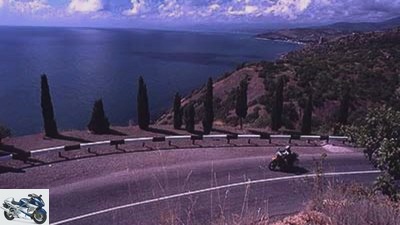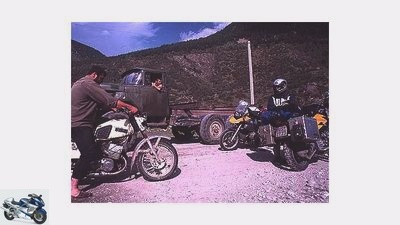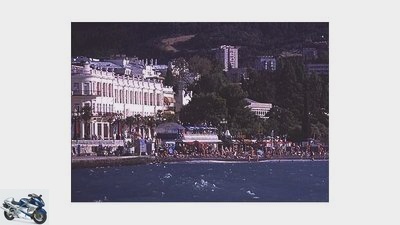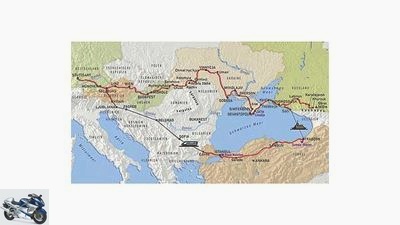Table of contents
- Eastern Europe Carpathians, Crimea and Caucasus
- Eastern Europe (2)
- Czech Republic, Slovakia, Hungary and Romania
- Ukrainian and Russian Riviera
- Eastern Europe: Travel tips – Enthusiastic about the East: Doris Wiedemann
- Hospitality in Eastern Europe

Schroder
to travel
Eastern Europe
Eastern Europe
Carpathians, Crimea and Caucasus
Protocol of a trip along the Black Sea coast to the highest mountain in Europe, Elbrus in the Caucasus. And why there will be a second trip there because of an insidious wooden bridge.
Michael Schroder
11/25/2005
On the way to the nightclub, Vitali explains the secret of his success to us: coffee machines. Made hundreds of times from Italy to Ukraine and sold for a profit. Plus bags of coffee beans. The hit in a country where there was only one soluble broth under decades of Soviet rule. Vitali speaks without dots and commas, the almost 30-year-old, whose pension we ended up in, speaks German fluently, plus English, Italian and a few bits of Spanish. Are we interested in a new project? The plans for a hotel in the Carpathian Mountains have long been ready. “But around 500,000 euros are still missing.” More of Vitali’s variety – and the Ukraine would be a new economic power in Europe tomorrow. Guaranteed.
The visit to the night club, which Vitali really wanted to persuade us to do, is omitted. Closed on Mondays. Or better: rest night. Lucky, think Thomas and I. Turn back and go to sleep? No chance. Vitali definitely wants to offer something else to his dog-tired guests. “How about a hard rock bar?” Thomas and I sit on our necks for the first 1700 kilometers. Stuttgart, Vienna, Budapest, and finally the border with Ukraine at Berehove. Uncertainty as to whether it has got around to the officials in the tiny mountain nest that tourists from Germany no longer need a visa. In retrospect, a completely unfounded concern. Show passport, a few crosses on a form, three questions about the route, bang – the stamp for entry pops on the document and a wipe that has to be handed in on departure. However, it is difficult to say whether we will ever find our way out of the country. Signs that only show the place names in Cyrillic cannot be deciphered while driving past on the first day – a real challenge at every intersection.
Because the hard rock shed turned out to be not that bad at all and it doesn’t work without a minimum amount of sleep, we don’t really get going until around noon the next day. Vitalis coffee – really good. Maybe cruise through the Carpathian Mountains for another day or two? They deserved it. Dense forests, lush green meadows, foaming white water. Visually a mixture of the Allgau and the Alps. And about as undeveloped as Alaska. One should have time. But so it means setting off in the direction of Odessa, which is already on the Black Sea. It’s 1000 kilometers of country roads to get there. Bolt straight. A look at the map promises one of those stages that you can only endure if you have a goal in mind. We even have two: the Elbrus, a 5633 meter high ice giant in the middle of the Caucasus, which – depending on the geographical definition (see box on page 105) – is considered the highest mountain in Europe. And the round around the Black Sea. That makes roughly 7,000 kilometers. Could be tight in three weeks.

Schroder
Every hint comes in handy when cards suddenly no longer help.
Especially since there are more pleasant things than having to do a route in the huge Ukraine. The diesel exhaust from the seemingly endless columns of trucks on the tattered highway somewhere between Chmel’nyc’kjy, Vinnycja and Uman almost drive us crazy. Prehistoric loads mostly of Russian origin. With smoking chimneys like ocean liners and yet hardly faster than the many horse-drawn vehicles that somehow try to survive on the verge. We feel immediately that motorcyclists are ranked lower in the pecking order.
A good 400 kilometers. More is just not possible. Various police checks and siege-like conditions as soon as we stop somewhere – in both cases the motorcycles are of interest – do not allow a better cut. In addition, the heat gnaws at our condition. 37 degrees in the late afternoon. The sun weighs heavily over the seemingly endless, flat land with its immeasurably wide fields of grain. Shortly after dusk we turn onto a small path and pitch our tent under the protection of a row of trees. Curry chicken out of the bag, two beers bought at the last gas station and a colossal starry sky around midnight. For a moment, happiness is perfect.
The next evening finally in Odessa. Neoclassical splendor on the Black Sea, at the same time the most important port in Ukraine and famous for its extravagant nightlife. In the hotel three Italian motorcyclists just before the evening stalk along the boulevard. “Che donne!” What women! The boys can’t get out of the swarming anymore. Even shorter skirts and even higher heels than at home on the piazza! In fact, there is full life in the center. Mostly young, fashionably dressed audience. The street as a catwalk for a grandiose courtship in the midst of countless pubs, restaurants and clubs. Booming bass, flickering lights, babble of voices. All the way down to the Potemkin Stairs, which achieved world fame through the silent film “Battleship Potemkin”, shot in 1925, and one of the most important films in film history. It’s just that we’re too tired to really notice it all. Tomorrow we will take our first of four planned days off.
Mykolaiv, Kherson, Simferopol ’. Another tough day on the move. Crossing the wide Dnieper and arriving on the Crimean peninsula are already the highlights. Otherwise flat agricultural land. Without a radio system we would have been bored out of our saddles on this stage.
Eastern Europe (2)

Schroder
When you see the beaches, the Elbrus seems infinitely wide.
Fortunately only a stone’s throw to Sevastopol ’. Until 1996 we shouldn’t even have approached this magnificent and extremely lively port city. Restricted military area. Isolated until you can no longer do it. Something like that makes you curious. We really want to take a look at the mysterious Russian Black Sea Fleet. Or what rust and financial distress have left of it: a few cruisers and submarines lumbering in front of them in the bay in the south-west of the Crimea, which is lined with derelict port facilities.
We are on course for Yalta. Speed along the cypress and vine-lined coastal road that leads around the sun-drenched southern tip of the Crimea. What a terrific route after the nightmare of the last few days! On one side there are white cliffs up to 1000 meters high, on the other the turquoise sea with tempting bathing bays. Surfers and jet skis like on the Mediterranean, bikinis like on the Copacabana, cafes and bars with soundtracks a la Cafe del Mar. A whole day is required for the 75 winding kilometers to Yalta – and another in the seaside resort itself, which became world-famous through the conference of the same name: Roosevelt, Churchill and Stalin determined the division of Europe in 1945 in the nearby Livadija Palace after the end of the Second World War. Not a place to simply rush past. Perhaps we have also been infected a little by the Ukrainians’ love for life. On Yalta’s shrill promenade, the party goes on into the morning.
The further course of the route to Feodosija remains brilliant. A single orgy of curves, mostly along the sea. At first we feel transported to the lush green hills of Tuscany, shortly afterwards to barren Andalusia. Finally the last kilometers in Ukraine to the port of Kerc. A ferry takes us across the channel that connects the Black Sea with the Sea of Azov and at the same time marks the border with Russia. We are nervous. Horror stories about corrupt Russian officials shoot through our heads, about arbitrariness, harassment and exorbitant demands for bribes. A bundle of US dollars crackles in my jacket pocket for all eventualities. Not necessary, as it turns out. Filling out the Cyrillic forms turns out to be a happening at the small post. Other travelers and the officials patiently teach us a lesson in their local language. After less than two hours we are rolling over Russian asphalt.

Map: Maucher
Time required: at least three weeks; Route length: 7500 kilometers.
Now there is no stopping us. Anapa, Novorossijsk, the dump of Dzubga, behind which we leave the coast and finally aim for the Elbrus. Two fantastic days of driving. The small villages with their simple, colorful wooden houses, dense forests and the vastness through which we slide are reminiscent of images from Siberia. The hustle and bustle of Ukrainian streets is completely alien to this remote part of Russia. Finally, the first hills and mountains herald the proximity to the Caucasus, whose wildly jagged contour we can occasionally make out. Absolute madness! The two BMWs suddenly run by themselves. However, many roadblocks indicate that the nearby mountain range that marks the border with Georgia is a highly sensitive region.
In Karacajevsk we have to choose. The actual way to Elbrus approaches the remote mountain from the east – which would mean two more long driving days for us there and back. Time that we actually no longer have. Much more tempting seems to us a slope that, according to the map, leads to Khurzuk, almost 50 kilometers away – a tiny mountain nest that must be close to the western flank of the Elbrus. We could be there in an hour.
As if euphoric by the thought of arriving at the destination of our journey before sunset, we dash through an impressive gorge. Right and left 2000, maybe 3000 meter high mountain peaks. Now we should actually be very close! Behind Khurzuk, barely more than two handfuls of poor huts, the asphalt ends. A slope follows a torrent – and the direction should be right. We hardly have a look at the fantastic valley through which the path leads. Our eyes are stubbornly directed upwards. The summit of Elbrus – just don’t drive past it. But we don’t get very far – the route ends in front of a military checkpoint. The border region with Georgia is a restricted area.
Back to Khurzuk, which is already in the shadows. “Elbrus?” We ask a couple of daring-looking shepherds. They point to the top left. Indeed – between two mountains there is a huge snow flank that finally disappears into the clouds. The Elbrus must be huge. There is a way to get there. On the other hand, our map doesn’t even show the gorge into which we turn shortly afterwards.
Czech Republic, Slovakia, Hungary and Romania
The Czech Republic and Slovakia have already dared to make the leap into the »modern«, but in parts of Hungary and Romania time seems to have stood still. A lot of uncharted territory for tourists.
Finally, the “East” shows a heart for mountain fans: The enchanting Giant Mountains on the Polish-Czech border, the vertically towering Hohe and the densely wooded Low Tatras of Slovakia, the small Bukk Mountains in eastern Hungary and the largely untouched areas Carpathian Mountains of Romania surprise with grandiose sights and views. The latter mountain range in particular leaves plenty of room for discovery tours – a tip for motorcyclists for whom the Alps are too known, too developed and too overcrowded. Just a few hours’ drive away: the Danube Delta. Where the three arms of the river flow into the Black Sea, a biotope unique in Europe (UNESCO biosphere reserve) has emerged that can only be explored by boat or canoe. Amazon feeling guaranteed! (MOTORRAD 12/2004). The way to get there is made easier by stops in cities such as Budweis (MOTORRAD 14/2004) or Litomerice (both in the Czech Republic), the Hungarian Eger or the tiny Sighisoara in the Romanian Carpathians (MOTORRAD 23/2005). Prague has always been considered worth seeing. While the Czech Republic and Slovakia tend to have a very good infrastructure, the situation is already different in the more remote regions of Hungary and especially in Romania (EU accession planned for 2007, no visa requirement). In one of the poorest countries in Europe, tourists are only gradually getting used to tourists in many places. The »East« actually has regions in store in which there is still something to discover. Romania is one of them.
Further information: Czech National Tourist Board, phone 030/2044770, www.czech-tourist.de; Tourist Office Slovakia, phone 030/4294113, www.slowakische.de; Romanian Tourist Office, phone 030/2419041, www.rumaenien-tourismus.de; Hungary Tourism, phone 030/24314613 (east), 069/92884613 (west), www.ungarn-tourismus.de. Literature: “Czech Republic”, Slovakia “,” Hungary “and” Romania “by Marco Polo for 7.90 euros each; “Discover the Giant Mountains” (13.95 euros), “Discover Slovakia” (13.95 euros) and “Discover the Czech Republic” (15.95 euros), all from Trescher Verlag. Motorcycle tours: MOTORRAD action team (Slovakia), phone 0711 / 182-1977, www.motorradonline.de; Fischtours (Romania, Czech Republic, Slovakia), phone 0351/8628500, www.fischtours.de; Enduromania (Romania), phone 069/6702652, www.enduromania.de; Hit Motorradreisen (Czech Republic / Slovakia), phone 0911/2878505, www.hitmotorradreisen.de; Roberts Motorradreisen (Romania), phone 0511/876050, www.roberts-motorradreisen.de; Roadbook tours (Hungary), phone 0711/6019314, www.roadbooktouren.de.
Ukrainian and Russian Riviera
Almost the entire northern Black Sea coast is to Ukrainians and Russians what the Mediterranean beaches are to us: a lively holiday region. As early as the 19th century, the royal family and the Russian aristocracy built their summer residences on the sun-drenched Crimean peninsula. Artists, writers and the financially strong upper class followed and settled in magnificent villas mainly around Yalta. During the Soviet rule (1922–1991), because of the mild climate in the Crimea, innumerable sanatoriums were built to cure lung diseases (tuberculosis), which took in up to ten million “spa guests” from the “working class” each season. Ukrainians and Russians are still drawn to the Crimea today. Those who can afford it reside in the hotels around the lively Yalta. The majority, on the other hand, populate the numerous small seaside resorts, some of which have quite simply furnished accommodations.
Similar is the development in the Russian seaside resort of Soci, which boasts of being in the “northernmost subtropics of the world”: palm trees, bananas and citrus fruits thrive along the coast. Stalin had also chosen this place as a bathing paradise for the working class – hundreds of sanatoriums, health resorts and holiday centers still line the coast today, which has a black sand and pebble beach about 30 kilometers long. Soci later developed into one of the most popular holiday destinations for the citizens of the GDR, which threatened to deteriorate during privatization after the end of the Soviet era due to a lack of money and guests. For a few years now, the Russian jet set and investors have discovered Soci for themselves: Today the seaside resort looks like a flashy (and by Russian standards expensive) party center.
Eastern Europe: Travel tips – Enthusiastic about the East: Doris Wiedemann
Two trips of several months through Eastern Europe and Asia took Doris Wiedemann (www.doriswiedemann.de) to Siberia, among other places. Your tips for “Eastern beginners”: Those who stick to a few safety rules hardly have to worry. In cities, the motorcycle should only be parked in guarded (hotel) parking lots, so-called »Stajankas«. Private hosts usually offer their own garage immediately. Away from the metropolitan areas, wild camping is generally not a problem, just not within sight of a village or a street, because visits (often only bystanders) are guaranteed there. Just in case: Have copies of all documents ready (in paper form and as a scanned document in the e-mail box). The Russian mafia – like the Italian – is not interested in individual tourists. The frequent police checks should be treated as calmly as possible. As a rule, questions about the condition of the road successfully distract from the actual control. A few bits of Russian can be learned quickly during the long stages, and a dictionary should always be close at hand. It is best to familiarize yourself with the Cyrillic alphabet before starting your journey.
Hospitality in Eastern Europe
Hospitality that is almost unparalleled, exciting coastlines; and two mountains that mark the edge of Europe ?? Visit welcome! Despite the huge distances.
Admittedly, it takes a good helping of meat to cover the huge distances in Ukraine or Russia in order to finally arrive at the actual destination. Between the still relatively untouched Ukrainian Carpathians, which mark the only significant elevation up to the Alpine Caucasus and the Urals, not much is happening in terms of landscape. Another exception: the Crimean peninsula, which is, however, an impressive 3000 kilometers away from Munich. In these countries, encounters on the roadside are suddenly one of the highlights of the trip: Ukrainians and Russians are enthusiastic and extremely friendly hosts. Other tourists between Moscow and the Ural Mountains? Nothing. You only meet them in larger towns and cities such as Dombay in the Caucasus (skiing, mountaineering, trekking), Odessa, Yalta and Soci on the Black Sea as well as in magnificent St. Petersburg. The Ukrainian L’viv (MOTORRAD 25/2004) is already being treated as the new Prague among city, culture and scene fans. Border formalities that are kept ever simpler (no more visa required for Ukraine) and a rapidly improving infrastructure no longer stand in the way of a motorcycle trip there. Belarus (“Belarus”, visa requirement), on the other hand, offers little worth seeing. Much of what is often referred to as the last dictatorship in Europe is still reminiscent of the situation in the former Soviet Union. Travelers to Russia should avoid the »police state« through the Baltic states or the Ukraine. Tiny Moldova (visa requirement) is also not a recommended transit country to shorten the way to the Black Sea due to a desperate economic situation and harassing police controls.
Further information: Ukrainian Embassy, phone 030/28887220, www.botschaft-ukraine.de (currently no visa requirement!); Embassy of the Republic of Belarus, phone 030/53635932 (visa section), www.belarus-botschaft.de; Russian Tourist Office, phone 0190/761655, www.russlandinfo.de; Russian Embassy, phone 030/22651184, www.russischebotschaft.de; Embassy of the Republic of Moldova, phone 030/44652970, www.botschaft-moldau.de. Literature: »Ukraine« (15 euros) and »Russia & Belarus «(30.20 euros) from Lonely Planet (prices depend on the exchange rate); “Discover Ukraine” (19.95 euros), “Discover Belarus” (16.95 euros) and “Discover Crimea” (14.95 euros), all from Trescher Verlag. Motorcycle tours: Ural Motorcycles (Ural Mountains and factory visit in Irbit), phone 0043 / (0) 732/245501, www.ural.cc; Edelweiss (Ural Mountains), phone 0043 / (0) 5264/5690, www.edelweissbike.com.
Related articles
-
Frank Wolf to travel Eastern Europe / Turkey Eastern Europe / Turkey The summit round The last semester break ?? And a very special travel wish should…
-
Royer to travel Eastern Alps Eastern Alps Over the peaks to the Adriatic Without detours from Austria to Croatia ?? With their KTM enduros, father and…
-
Motorcycle tour in eastern Switzerland: Appenzell
Iron ham to travel Motorcycle tour in eastern Switzerland: Appenzell Motorcycling in Switzerland Motorbike tour through the Appenzellerland Granted, the…
-
wolf to travel On the move in Eastern Europe On the move in Eastern Europe Once the Baltic Sea – Aegean Sea Adventure is only available in Africa or…
-
Annetzberger to travel Eastern Europe: Lithuania Eastern Europe: Lithuania Dunes, myths, new times A motorcycle trip to the Baltic States is still a bit…
-
Mahindra enables Jawa comeback – also in Europe
Jawa 19th pictures Jawa 1/19 Jawa presented the new Jawa 300 in India. Jawa 2/19 The single-cylinder has an output of 27 hp, has a retro look and costs…
-
Tolls for motorcyclists 2019 – overview of the charges in Europe
Lohse counselor Tolls for motorcyclists 2019 – overview of the charges in Europe Toll for motorcyclists 2019 Overview of fees in Europe Anyone planning a…
-
MV Agusta motorcycles News: Europe and USA News: Europe and USA Harley-Davidson and MV Agusta For the 105th company anniversary, the successful series of…
-
Zero electric motorcycles: first shop opened in Europe
Zero Motorcycles counselor traffic & business Zero electric motorcycles: first shop opened in Europe Zero electric motorcycles First shop opened in…
-
Daams to travel Dream routes in Europe Dream routes in Europe Europe’s 20 strongest routes Daring combinations of curves, grandiose landscapes, goose…